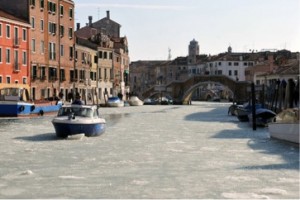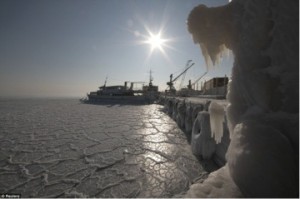Since the end of January 2012, Europe has been experiencing record-breaking cold temperatures and heavy snowfalls. Temperatures are dropping to -40°C (-40°F) and below in Europe. The canals of Venice are freezing over (the first time since 1991) and sections of the Black Sea have frozen (the first time since 1977). And, Rome has received its first substantial snowfall since 1986.
So, why is it so cold in Europe? Part of the reason for the cold temperatures can be attributed to a climate pattern called the Arctic Oscillation (AO). There are many different kinds of climate patterns, which are also called teleconnections or oscillations. Climate patterns can occur at different time scales too – some might change every few weeks, others might take decades to change. Imagine that you and a friend are on a seesaw – sometimes you are up, sometimes you are down. Climate patterns work the same way, although the phases are called “positive” and “negative.” A well-known climate pattern is the El Niño/La Niña Southern Oscillation (ENSO).
When the AO is positive, surface air pressure is low in the Arctic and the cold air stays in the region. However, when the AO is negative, surface air pressure is high in the polar region and the frigid air spreads into the middle latitudes of the Northern Hemisphere. (For those of you that have some familiarity with meteorology and air pressure systems – remember that air converges into a low pressure system and diverges from a high pressure system.) Currently, we are in a negative phase of the AO, which can be related to these cold conditions in Europe. Even though North America is also in the middle latitudes of the Northern Hemisphere, it is experiencing a milder (warmer and drier) than usual winter. Well, this is because there are even more climate patterns in play! Along with a negative AO, we are also experiencing a positive North Atlantic Oscillation (NAO), which often relates to winters in North America being warmer than usual, and the La Niña phase of ENSO, which has been tied to less precipitation in the American Southeast. Due to these different climate patterns in play, this winter has been extremely cold in Europe and moderate in North America.
When we have extremely cold temperatures, you might hear people saying that this means global warming isn’t really happening. However, some scientists think that warming air temperatures in the Arctic are actually causing this extreme cold in Europe. When sea ice in the Arctic melts, this can cause the phase of the AO to become negative and then can lead to cooler temperatures in the middle latitudes of the Northern Hemisphere. As the overall temperature of Earth continues to warm and more ice melts in the Arctic, we may see more of these extreme cold events in the middle latitudes.
Scientists are able to discover all of these climate relationships by analyzing large amounts of climate data and looking for patterns. Having a lot of high quality data is very important to discover these patterns. If you look at the weather data for your school, do you notice any patterns? Some should be obvious – like warm air temperatures in the summer and cold air temperatures in the winter. Can you find any patterns not related to just the seasons? Depending on how long your school has been recording data, you can probably find patterns in different time-scales too.
The GLOBE Program is encouraging teachers and students to collect weather and climate data, as well as conduct climate-related research investigations, as part of the ongoing Student Climate Research Campaign (SCRC). Make sure to get your school involved and help contribute to our GLOBE database!
Are you in Europe? Send us an email or add a comment to let us know your experiences during this extreme weather.
-JSM



This winter was really cold. Here in Poland we had -20 C in January, but earlier in December the temparatures were above +10 C, which is very high. This is crazy
Thanks God for the Chife of Science for receiving email from the Public and other Agency…
Here in the UK, the winters of 2009/10 and 2010/11 were unusually cold with amounts of early snowfall we have not seen for quite a few years. These winters were then followed by warm and dry springs but poor summers. This winter was less cold and not as much snow. Because we have had lower levels of rainfall than usual over the last few years, in early April the water companies introduced a drought order and hosepipe ban due to very low reservoir and groundwater levels. Since then we have had virtually non-stop rain!
Thanks for the great information explaining why there is snowfall and the climatic pattern change. I think not many people would be knowing this information. I’m going to share this with others.
thank for share.